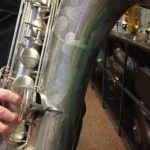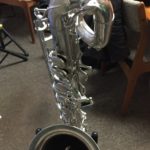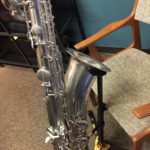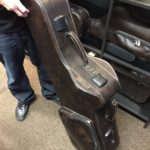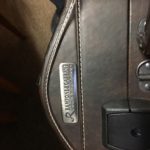The Wilmington-Conn 12.5M Neck Review
Review by Andrew Hadro
The good people at MusicMedic.com recently sent me a Wilmington-Conn 12.5M neck to try out. Check out the video for an overview and some sound comparisons. Here’s the basic takeaway: if you have an old Conn that plays really sharp, this neck is a fantastic option to adjust the pitch.
Check out the video for an overview and playing demonstration, otherwise dive in below for the details and more.
What is it?
Some older Conn baritone saxophones, usually 12M’s play really sharp. One thought is that the problem is derived from modern mouthpieces having smaller chambers and therefore driving the pitch higher. Personally in my measurements and observations of baritone mouthpieces the chambers in modern mouthpieces aren’t that much smaller, and certainly not enough to account for 20-30 cents of pitch difference. Furthermore, not all old Conn’s have tuning issues and on many of them modern mouthpieces tune really well. I also don’t hear this reasoning applied nearly as often to altos or tenors or other brands of vintage horns. So it might be horn or mouthpiece dependent.
Some people try soldering extensions onto necks, or adding extensions onto mouthpieces, but this is just adding length and can make the response and overall playing very uneven, as a proper fix is to not just add length, but adjust volume as well. The 12.5M neck that Music Medic developed is newly made neck that is longer as well as having a larger diameter and bore dimensions. This has the net effect of lowering the pitch without screwing anything else up. There are plenty of other differences as well that we’ll get into, but the main objective behind these necks is lowering the pitch. The Wilmington part of the title refers to Wilmington, North Carolina – the location of Music Medic’s shop.
Curt Altarac, who is the mad genius behind Music Medic is a big Conn fan and a baritone fanatic. This project is clearly a labor of love for him. There have been newly made necks for baritones before, almost always for Selmer’s though. And lately a lot of people are getting into the custom made neck game (KB Winds in Queens NY, Boston Sax Shop to name a few) but they almost always focus on tenor, sometimes alto, and again, almost always for Selmers.
Whats in the box
The neck comes very well packed. It has a custom made box, with a fit styrofoam cut out to protect it in transit. They even made custom stickers for the box, which is a very nice touch. A lot of times small batch custom made saxophone parts or accessories come without any real branded packaging. There is a nice custom pouch that comes with the neck, sized to fit, with space for a mouthpiece perhaps. The neck was in a zip lock bag, with what I think is a silver protector strip to prevent tarnishing – a small detail, but a nice touch. The neck I had to try was silver plated with a sand blasted finish, but there are a number of different plating and finish options.
Build Quality
The neck is beautifully made. All of the soldering and construction is very clean and sturdy. I don’t have a way of testing the quality of the metals used, but given Music Medic’s reputation and the fact that this is a project derived from love of vintage horns more than sheer profit, I feel pretty safe in assuming that very high quality materials would have been used. The tenon and brace seem very solidly put together and the octave mechanism is substantial and should hold up very well.
I don’t personally love the aesthetic of the silver “satin” look – silver plating with what I think is maybe a sand blast finish. But the plating and the satin finish looked to be very well done, with no blemishes or inconsistencies. They also offer regular plating with or without the satin finish, silver, brass, and even gold. And hey, some people love the satin look so kudos to them for offering so many options.
Tuning
My Conn 12M doesn’t suffer from the intonation issue these necks are designed to fix, but I did play the neck and check it with a tuner. I put the mouthpiece about halfway on, so I could easily lower the pitch further or raise it a bit. With the mouthpiece in the middle, the neck tuned approximately 30 cents lower than my normal neck! This should definitely give enough room for even horns that are a quarter step (50 cents) away from normal tuning. I found the tuning consistent throughout the range of the horn, or at least no more inconsistent than my normal Conn neck!
Octave Mechanism – No more hissing!
Other than the length/tuning difference possibly the biggest difference from regular 12M necks is the octave mechanism – both the arm system and the chimney/hole. As opposed to the normal two small posts soldered directly onto the neck the 12.5M has one solidly built piece with a very interesting double headed screw system. This holds a flat spring similar to the traditional necks, but the whole thing feels a bit more substantial and perhaps less prone to damage. One thing to note is that due to every conn 12m being different the alignment of the bottom of the arm to the receiver and mechanism on the body of the horn may need to be customized or adjusted by a repairman (or a handy saxophonist) to make sure the octave opens properly and the proper amount at different angles etc.
I also noticed that the cup for the octave key pad is quite over-sized. I am not sure of the purpose of this but it’s definitely intentional, being maybe twice the diameter of the original. The pad installed was a black pad, I’m not sure if it was a dyed leather pad, roo pad, or synthetic, but it looked up to the job.
- Octave key chimney on the 12.5M
- Octave key chimney comparison – original in front, 12.5M in back
- 12.5M Neck octave system
A very important and large difference is the actual chimney or hole in the top of the neck for the octave key function. A lot of Conn 12M necks (including mine) have a very audible hiss when you play A, Bb, or B in the upper octave. This is due to a poor design in the octave key – it disappears if you play these notes without the octave key engaged, but you don’t get the assistance you normally would with the octave key. The proscribed fix is to stretch a piece of nylon over the opening to disrupt the air stream, and while this helps a little it does not resolve most of the hiss. The design and shape of the chimney on the 12.5M neck is completely different. It actually resembles the design of the secondary octave key stem found on the horn. I don’t know if its this, or the combination of the bore, over-sized pad etc, but the hissing is non-existent. This to me alone, is worth the price of the neck, let alone with the tuning help.
Tenon and cork
The size of of receivers and therefore tenons on old saxophones and especially Conn baritones can change drastically from one to the next. I actually provided the diameter of my receiver to Music Medic and they were kind enough to make sure the tenon was properly sized to fit. I originally went to try these necks a year or two ago and couldn’t because they didn’t fit my horn. Music Medic was also kind enough to size the cork to my mouthpiece as well. Both these things are something a local repairman should be able to do without too much difficulty.
The length of the tenon can also vary, but according to my comparison of 4 different necks the tenon length of the 12.5M matches the length of most of the necks, so should fit the length of most receivers just fine.
Brace
The design of the brace is quite different. On the standard 12M neck a thick band of brass is soldered to the under the neck following the curve. This is primarily to help prevent the “pull down” that can happen to necks especially when a mouthpiece is attached acting as a lever. The brace on the 12.5M neck is more of a bridge looking design. Instead of a band soldered the whole way its a large piece of metal affixed in 4 places that should provide stability. There is also a Wilmington logo built in. You’ll see in the photos that there is a blue covering on the brace, but I am not sure if this is the design or some protective covering left on from manufacturing.
Neck Angle & Playing the neck
Perhaps the only thing I didn’t immediately love about this new neck is the different angle. The angle of the neck is a bit higher on the 12.5M than a regular neck. I personally didn’t prefer this angle but I know some people who would – personal preference here. The higher angle in addition to the extra length of the neck put the horn much farther away from me while playing and changed the feel quite a bit.
The neck played incredibly well. At least as well as my own neck – possibly better if you take into account the fixed hiss. This is an incredible achievement as I have tried a lot of old Conn necks and I prefer mine to any other I’ve tried so far, with some being really terrible. Playing the actual horn felt great, very similar sound and articulation response/attack wise. Perhaps a little brighter with more projection – possibly from the silver material? Hard to say. How well the neck played is particularly astounding given that I was playing about 30 cents flat – horns tend to respond and play best when closest to in tune since the tone holes are designed with that in mind – and my horn doesn’t have the tuning issue this neck is designed for, hence the flat pitch. Check out the video for the back to back playing examples.
Finishes
As mentioned, the neck I had to review was the silver satin finish. The satin finish referring to a matte finish that I think is done with sandblasting. They also offer a straight plating finish for those that don’t want the satin finish. I image the satin option is purely aesthetic as I don’t think that would have too much affect on the sound or playing of the neck. They do offer a gold plated, gold satin, regular brass, and brass satin finishes as well as the silver plating and silver satin finishes. I imagine the straight brass and gold plating will alter the sound somewhat.
Pricing
The brass or brass satin finish are $750. This a bit more than you’ll find most replacement necks for, especially if you’re buying a standalone neck on Ebay. But those necks can be terrible. Also, if you have a horn that is too sharp to comfortably play this neck is a fantastic option, and the only thing of its kind out there. If you want silver plating it’s an additional $150 ($900 total), and the gold option is an additional $290 ($1040 total).
If you want to order the Music Medic Wilmington-Conn 12.5M you can do so on their site:
http://musicmedic.com/products/saxophone-necks/wilmington-saxophone-necks/conn-12m-proshop-neck.html
Other notes
The only other thing I’d like to note is that Music Medic also offer’s a regular 12M neck replacement, as well as high quality made necks for Buescher and Martin baritones.
Check them all out on their site!
Do you own, or have you tried the 12.5M neck? Leave a comment below!




